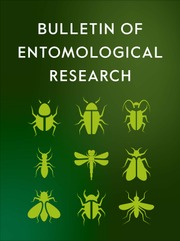Article contents
Analysis of the effects of nanosilver on bacterial community in the intestinal fluid of silkworms using high-throughput sequencing
Published online by Cambridge University Press: 27 September 2019
Abstract
Nanosilver is an environment-friendly, harmless alternative of traditional disinfectants which can be potentially applied in the sericulture industry. However, the effects of nanosilver on the intestinal bacterial community of the silkworms (Bombyx mori L.) are unclear. In this study, Illumina MiSeq high-throughput sequencing technology was used to assess the intestinal bacterial community in both male and female silkworms while treated with different concentrations of nanosilver. We found that nanosilver significantly influenced the composition of silkworm intestinal bacterial community on the different taxonomic levels. Most conspicuously, the abundance of Firmicutes was increased by the treatment of 20 mg L−1 nanosilver but decreased by that of 100 mg L−1 nanosilver at the phylum level. The same trend was observed in Bacilli at the class level and in Enterococcus at the genus level. In some extreme cases, application of nanosilver eliminated the bacterium, e.g., Brevibacillus, but increased the population of several other bacteria in the host intestine, such as Blautia, Terrisporobacter, Faecalibacterium, and some bacteria could only be found in nanosilver treatment groups, e.g., Dialister. In addition, although nanosilver generally showed negative effects on the cocooning rate in a dose-dependent manner, we found that 20 mg L−1 nanosilver treatment significantly increased the body weight of silkworms and did not show negative effects on the survival rate. These results indicated that the intestinal bacteria community of silkworm larvae was significantly changed after nanosilver treatment which might consequently influence host growth and development.
Information
- Type
- Research Paper
- Information
- Copyright
- Copyright © Cambridge University Press 2019
References
- 12
- Cited by


